
The Masaii tribe are famous around the world. The vibrant red of their Skuka cloth is iconic, as is the intricate beadwork which adorns many in the tribe, the rungu, a wooden throwing club used by Masaii morans – young, male warriors – and their adumu ritual; a jumping dance.
It’s believed that the Masaii arrived in Kenya more than 500 years ago, migrating from the lower Nile region of the Sudanese and Ethiopian border to the more fertile land in the Rift Valley.
“We can walk a long, long way,” says Lemara Mereru, a Maasai warrior and guide in the Loita Hills. Indeed, Maasai morans can cover distances as large as 50 miles quite casually in one day. “We tend to go on shorter walks with guests,” he laughs. “We see giraffes, zebras and antelopes and more. We live amongst nature peacefully – even wild animals we don’t usually kill. It’s a taboo.”

Livestock is important in Maasai life, with the culture being rooted in nomadic pastoralism – grazing cattle and moving around the land. “Livestock provides us with food – the blood and milk we need,” he says. Even these livestock are rarely killed, only being slaughtered for ceremonial purposes.
This has long been the way for the Maasai – a semi-nomadic tribe known as fierce warriors, who raided cattle from neighbouring territories – though many Maasai were displaced and moved to less fertile ground during the colonial era, and even today, modern border disputes, conservation and property ownership impacts on access to land the Maasai have wandered for generations.
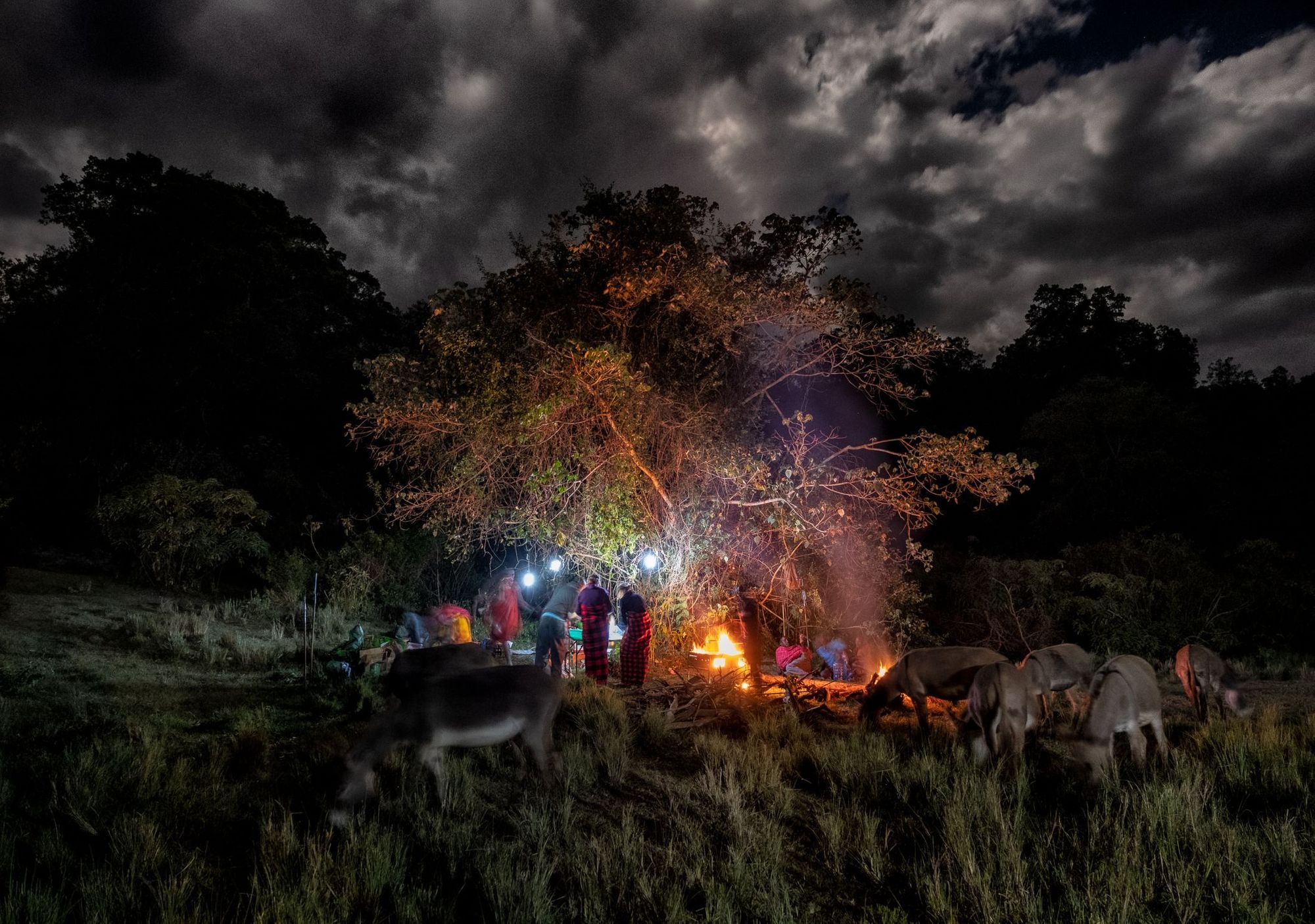
For the Maasai, land is not a commercial entity, but an essential resource.
Lemara Mereru’s tribe lives in the Loita Hills, which sits on the western edge of the valley, near the border with neighbouring Tanzania. Sandwiched between the Maasai Mara and the Amboseli, north of the Kenyan capital Kenyan of Nairbor, this area doesn’t attract nearly as many visitors as the other aforementioned destinations – but its beauty is no secret to those who live there.
“We explain our culture to our guests at night around the campfire,” says Lemara. “We share our knowledge about the trees and the birds, and about how we build our huts. We’re connected with nature – and we see starlings, weaver birds, bare-face go-away-bird, and of course, a lot of other species too.”
Indeed, the hills are home to the ‘Forests of the Lost Child’, so-called because of the blanketing mist which often descends upon them. Beyond lies a dense collection of lush vegetation and jungle, reaching high, far and full of vibrant wildlife – where lions, leopards and elephants roam wild and drink at lakes which are littered with flocks of flamingos, backdropped by African skies.
The Way of the Warrior
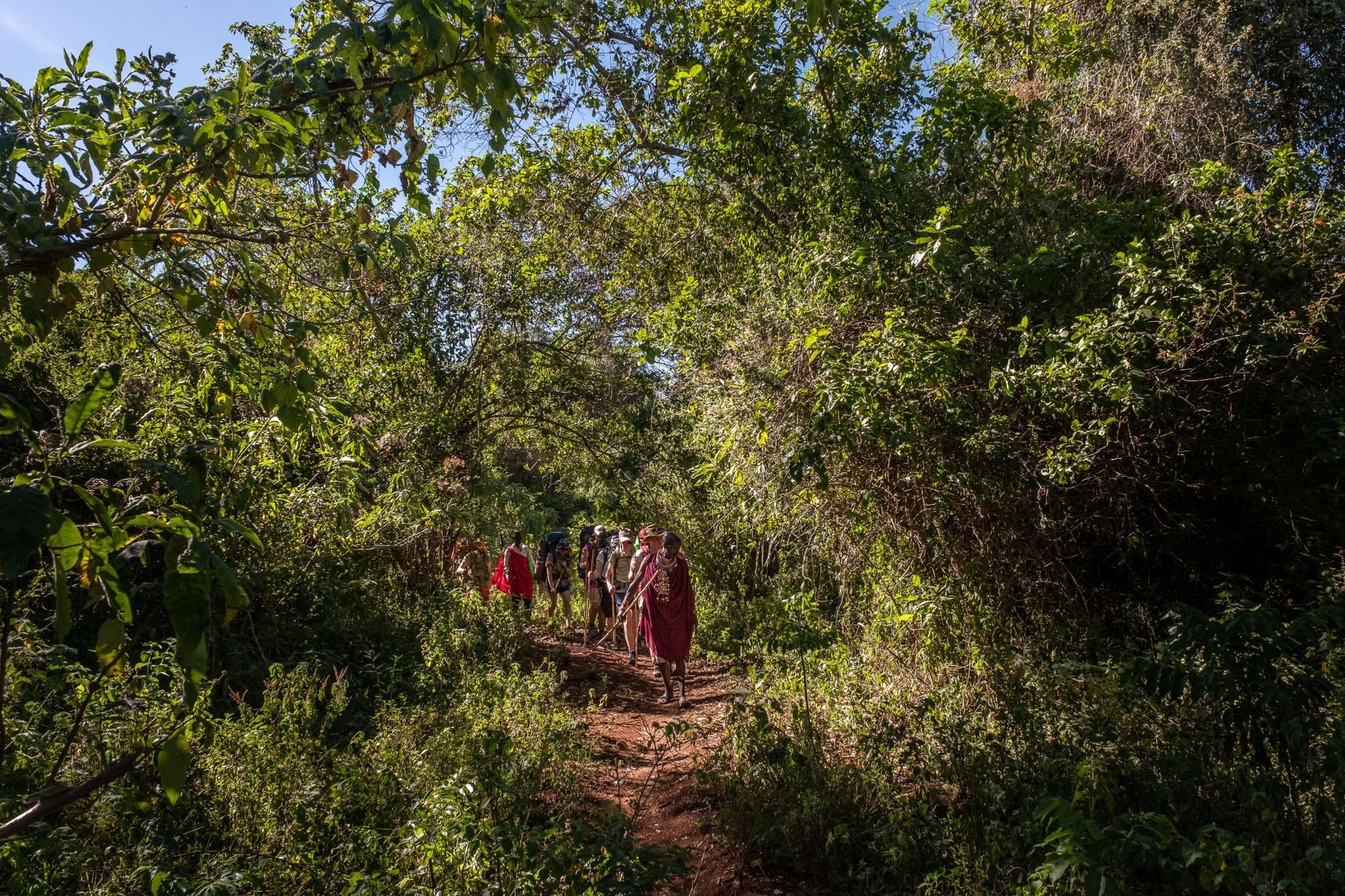 A Maasai guide leads a group of travellers through the forests of the Loita Hills. Photo: Much Better Adventures
A Maasai guide leads a group of travellers through the forests of the Loita Hills. Photo: Much Better AdventuresMereru has just finished his warriorship – one of the many stages of a Maasai tribesman’s life.
“It’s a right of passage for every man of Maasai to become a warrior after circumcision,” says Lemara. “Then you go through warriorship for four to six years. It’s a must to become a warrior.”
Enkipaata, the circumcision rite, is the most important rite in Maasai culture. “Boys are circumcised at 14 or 16,” Mereru tells me. The ceremony takes place in front of the person’s age mates, with the Maasai tribe tracking age in terms of age groups and sets, rather than by annual birthdays. “Nobody asks ‘how old are you?’ here,” says Mereru, “because nobody knows the exact time they were born. Instead, you would ask ‘what age group do you belong to?’”
The warriorship is the most important ceremony in our culture.
Traditionally, the Maasai also practise FGM/C (Female genital mutilation/cutting), however, in the Loita Hills, SAFE Kenya has been working towards the abandonment of FGM/C, in a community-led intervention created by the all-Maasai team, SAFE Maa.
Through the development of an alternative rite of passage involving cow’s milk, sacred in Maasai culture, they have significantly decreased the number of young girls being cut. In 2019, cultural leaders gathered to abandon the practice, and bless this new rite – which is known as the Loita Rite of Passage (LRP).
“Since the declaration of abandonment and the blessing of the LRP, the team have seen a significant increase in the social status of uncut women, and other women having the courage to reveal their secret uncut status,” says SAFE Maa.
Still, many families fear that their girls will not be able to marry if uncut. SAFE Maa continues to open up conversations about this previously taboo topic, and spread the word through traditional song, workshops, artwork and more.
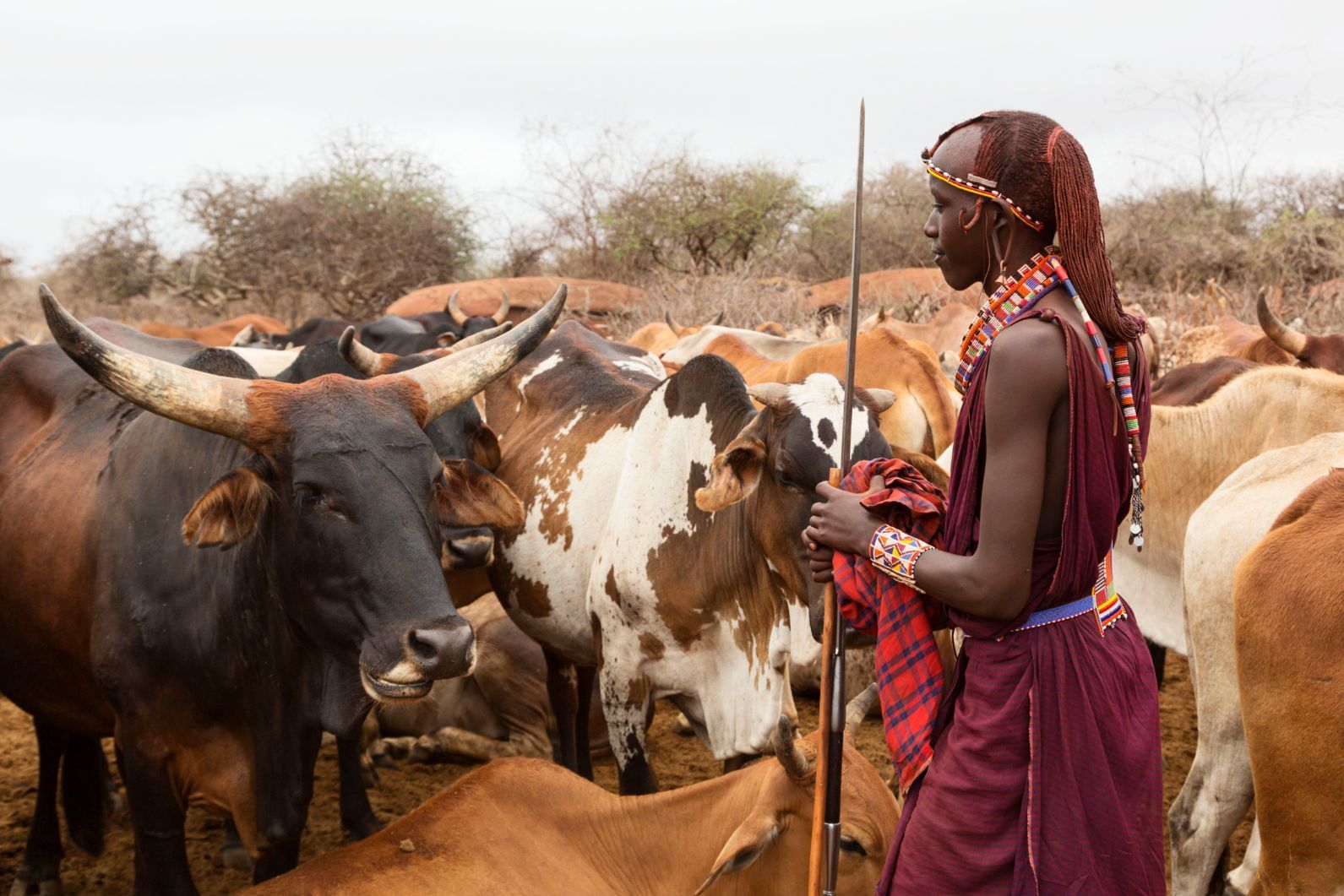 A young Maasai warrior (moran) with cattle in background. Note the braided hair of the morani and traditional jewellery and pierced earlobes. Photo: Getty
A young Maasai warrior (moran) with cattle in background. Note the braided hair of the morani and traditional jewellery and pierced earlobes. Photo: GettyThe circumcision of young boys is a rite of passage both eagerly-anticipated and dreaded in equal measures by those involved. The circumcision is carried out by a seasoned expert – without pain relief, and the boys must undergo the procedure without flinching. This is a celebration of their manhood and strength – a sign that they are ready to confront any and all danger, and something the young Maasai boys have been gathering courage for all of their lives.
“The warriorship is the most important ceremony in our culture,” says Lemara. “Every [male] member of the Maasai community must become a warrior.”
Afterwards, the boy earns the respect of his tribe, and receives gifts of livestock. Following this ceremony, there is then a healing period of several months, after which, they are a moran, a young warrior who’s role is to protect the Maasai people. Maasai warriors carry spears and grow out their hair, braiding it tightly. They also herd cattle and protect their own tribe from the raids of others. They’re prohibited from marriage and alcohol during this time.
The Maasai culture is one rich in ceremony and tradition.
“When a woman gives birth, she is not allowed to shave off the hair of the child until the baby starts walking,” says Mereru. “Then we have a ceremony to shave the baby’s hair during the daytime, and then at night, we give the baby a name.”
There are various community roles in Maasai culture, which are handed out by the elders. Lemara is a guide, greeting tourists from around the world. “We benefit from tourism,” he says. “It gives us jobs – and if I get money from tours, then that also benefits my neighbours and my tribe.”
Maasai and Tourism
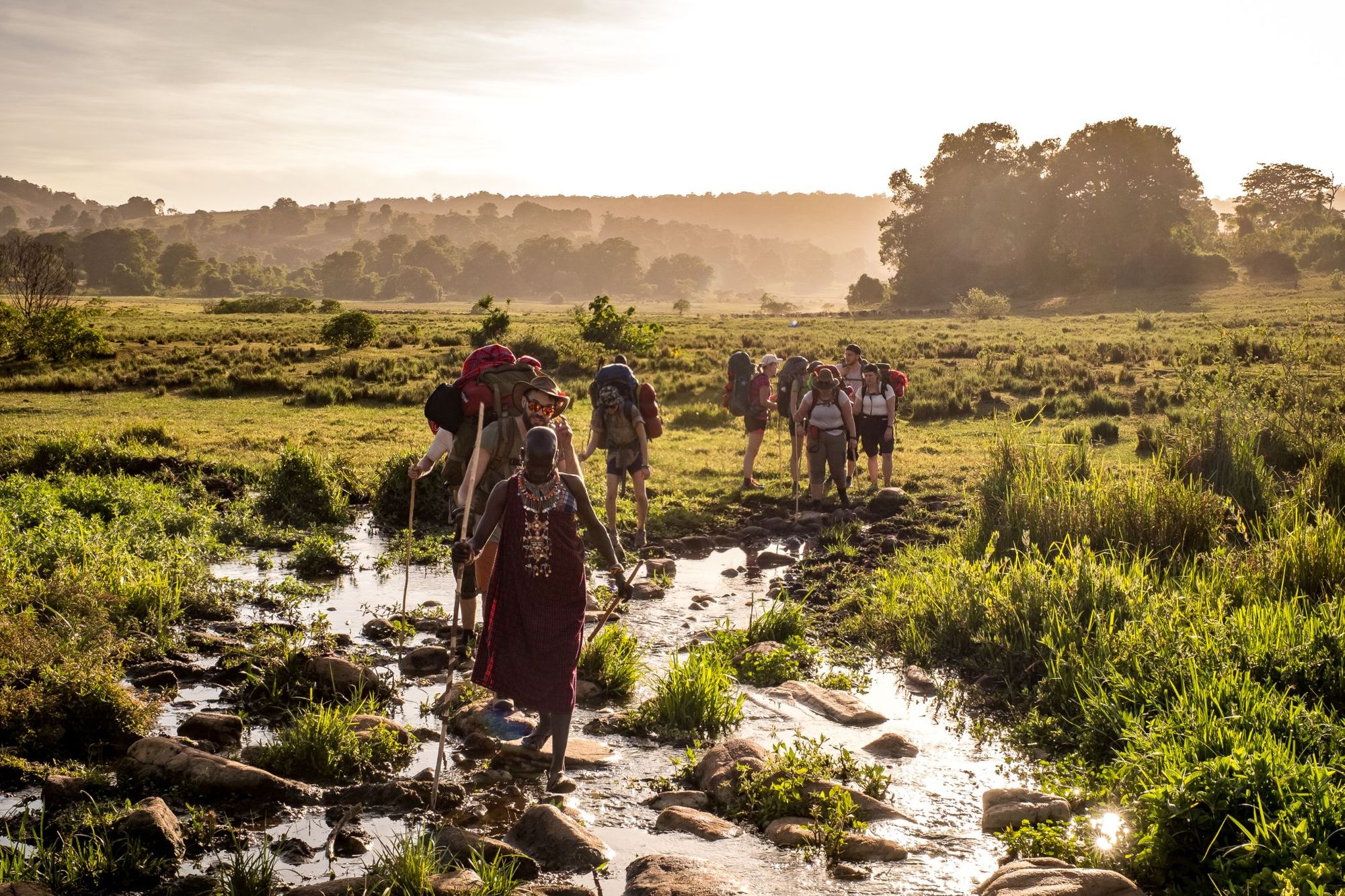 A group being led over the plains of the Loita Hills by a Maasai Warrior and guide, adorned in beadwork. Photo: Much Better Adventures.
A group being led over the plains of the Loita Hills by a Maasai Warrior and guide, adorned in beadwork. Photo: Much Better Adventures.The Maasai people have a long and at times problematic history with tourism. They are excluded from many national parks and reserves in the name of conservation (and often luxury safaris), even though they may have grazed their cattle there, alongside the local nature, for many hundreds of years.
The government insists that tourism brings in money, but the Maasai often do not see that money. Earlier this year in Tanzania, Maasai people were again displaced by government plans to lease over 1500 square kilometres to a royal-owned Dubai Company OBC for tourism and trophy-hunting. Authorities were then captured on film opening gunfire and tear-gassing Maasai protestors.
These territories are now important nature conservation areas precisely because the original inhabitants took such good care of their land and wildlife.
Fiore Longo of Survival International said: “The theory is that humans – especially non-whites – in Protected Areas are a threat to the environment. But Indigenous Peoples have been living there for generations: these territories are now important nature conservation areas precisely because the original inhabitants took such good care of their land and wildlife.”
If you are planning to visit Kenya or Tanzania, you should be aware of this history, and seek out areas where tourism is working for Maasai culture, paying the tribe fairly, with the community itself involved in the project, and Maasai culture respected. In the Loita Hills, the Maasai work as guides, security, chefs and porters. They sell their goods as food, rent out camping grounds and sell beads from their enkangs (homesteads) or manyattas (ceremonial bush camps).
Visitors can make the most of these visits to homesteads by not standing and staring, or watching through a camera lens (it’s a matter of manners to ask before taking photographs here, as you would do anywhere else), but by simply talking to the Maasai tribespeople, many of who will speak English, and asking about their culture and traditions, of which they are fiercely proud.
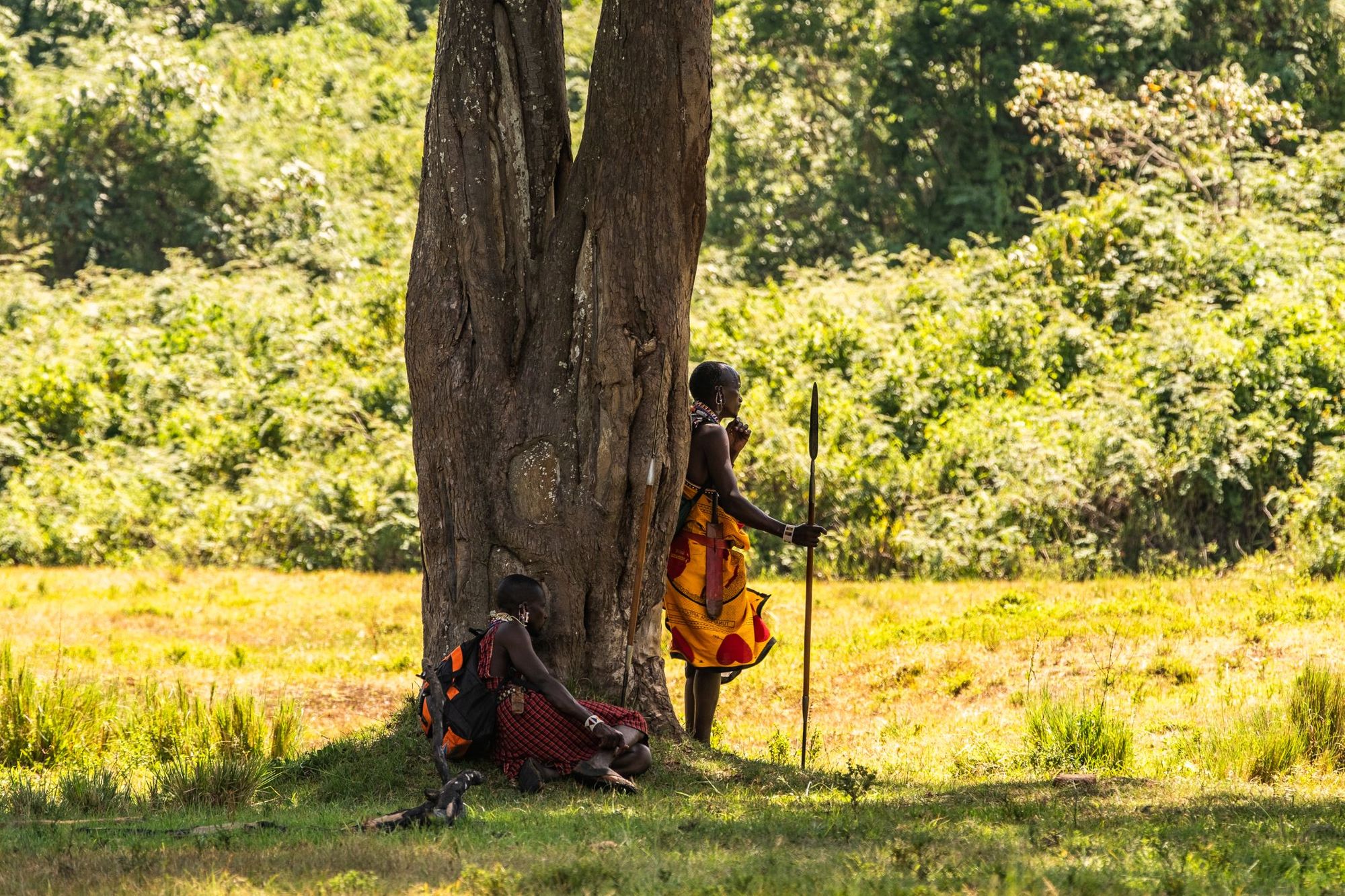 Two members of the Maasai tribe looking out on the lush vegetation of the Loita Hills. Photo: Much Better Adventures
Two members of the Maasai tribe looking out on the lush vegetation of the Loita Hills. Photo: Much Better AdventuresDone right, tourism can help fund education and establish community groups.
But while Maasai in the Loita Hills welcome tourism, the tribe are not naive. In recent decades, the Maasai people have been urged to change everything from their education system to their nomadic lifestyle, usually for the gain of others. The modern demand for ‘authentic’ tourist experiences also comes with the issue of that ‘authenticity’ being judged, and thus moulded, by an outside gaze.
“We know things are changing and changing, but we want to keep our culture,” says Lemara Mereru. “We have kept our culture and the traditions of the Maasai, and now we see visitors as a blessing. The word ‘strangers’ doesn’t exist here, so the people staying with us are visitors.”
Mereru enjoys trading philosophies with people from different countries.

Around ten years after becoming a moran, Masaii warriors undergo another ceremony, the Eunoto, where warriors shave their long hair and become senior warriors, after which they can marry and have a family. Later in life, they go through Ol Ngesherr, another rite of passage, which marks the beginning of eldership (and there are, of course, numerous other stages in between).
To the naked eye, it might appear like Maasai culture hasn’t changed in hundreds of years, but the modern world has had an impact. After all, Lemara Mereru and I chat back and forth over What’s App for this article, while all-Maasai teams are working towards abandoning FGM/C, and the roles of morani are changing. But the tribe have kept their culture alive, something, Lemara tells me, other tribes in Kenya admire – and even come to visit and see.
In the Loita Hills, where montane rainforest spreads far and wide, the Maasai people are still practising their traditions, while living alongside a flourishing, but everchanging natural world.
Inspired? Check out our Ultimate Kenya Wildlife Adventure now, which includes a walking safari guided by members of the Maasai tribe!